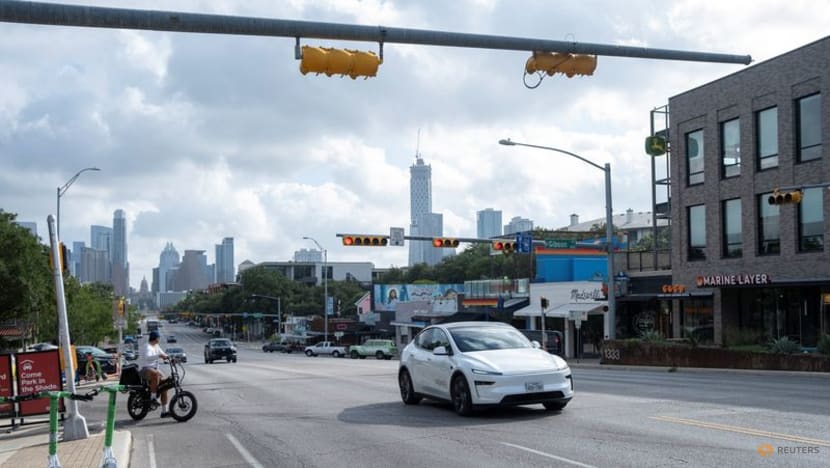Analysis:Why Tesla's robotaxi launch was the easy part

A Tesla robotaxi drives on the street along South Congress Avenue in Austin, Texas, U.S., June 22, 2025. REUTERS/Joel Angel Juarez/File Photo
Tesla finally has a robotaxi. Now comes the hard part.
The electric-vehicle maker deployed its first-ever driverless cabs in Austin, Texas, on Sunday in a small-scale test of carefully monitored Model Y vehicles. Next, the company faces the steep challenge of executing on CEO Elon Musk’s ambition to refine the software and upload it to millions of Teslas within a year or so.
Such a rapid expansion will prove extremely difficult, about a dozen industry analysts and autonomous-vehicle technology experts told Reuters. These observers expressed a range of views about Tesla’s prospects but all cautioned against assuming a light-speed robotaxi rollout.
Some pointed to advantages Tesla might exploit to overtake rivals including Alphabet’s Waymo and a host of Chinese auto and tech companies. Tesla has mass-manufacturing capacity, and it pioneered remote software updates it can use for self-driving upgrades. The automaker also does not use sensors such as radar and lidar like Waymo and most rivals; instead, it depends solely on cameras and artificial intelligence.
“A rollout could be really quick. If the software works, Tesla robotaxi could drive any road in the world,” said Seth Goldstein, a Morningstar senior equity analyst, while cautioning that Tesla is still “testing the product.”
In Austin, Tesla launched a choreographed experiment involving maybe a dozen cars, operating in limited geography, with safety monitors in the front passenger seat; remote “teleoperators”; plans to avoid bad weather; and hand-picked pro-Tesla influencers as passengers.
For years, Musk has said Tesla would soon operate its own autonomous ride-hailing service and also turn any Tesla, new or used, into a cash-generating robotaxi for its customers. That will be “orders of magnitude” more difficult than testing in Austin, said Bryant Walker Smith, a University of South Carolina law professor focused on autonomous-driving regulation.
“It’s like announcing that, ‘I’m going to Mars’ and then, you know, going to Cleveland,” Smith said.
Musk has said Tesla will reach Mars, in that metaphor, quite quickly: "I predict that there will be millions of Teslas operating fully autonomously in the second half of next year," he said in April.
Musk and Tesla did not respond to requests for comment. Tesla shares ended 8.2 per cent higher at $348.68 on Monday on investor enthusiasm over the robotaxi launch.
Given Tesla’s AI-dependent approach, its challenge will be machine-training robotaxis to handle complex traffic “edge cases,” said Philip Koopman, a Carnegie Mellon University computer-engineering professor and autonomous-technology expert. That could take many years.
“Look, how long has it taken Waymo?” Koopman asked. “There's no reason to believe Tesla will be any faster.”
LONG SLOG
Waymo’s self-driving efforts date back to 2009, when Google started its self-driving car project. An egg-shaped prototype took its first ride on public streets in 2015 – also in Austin.
Waymo has taken since then to build a 1,500-robotaxi fleet in select cities. A Waymo spokesperson said it plans to add 2,000 more vehicles by the end of 2026.
Some analysts believe Tesla can expand faster, in part because Waymo has helped pave the way by overcoming regulatory and technical challenges.
“Waymo and other pioneers have helped to drive regulatory change and have made riders, pedestrians and other road users aware of autonomous vehicles,” said Paul Miller, an analyst at market-research firm Forrester.
Being a mass-manufacturer also helps Tesla, Miller said. Waymo buys Jaguar I-PACE SUVs and outfits them with more expensive sensors and technology than Tesla integrates into its vehicles.
Waymo declined to comment on Tesla's robotaxi-expansion potential. The company’s former CEO, John Krafcik, remains skeptical. The precautions Tesla employed in Austin reveal it does not have confidence its technology is safe at scale, Krafcik said.
“And they shouldn’t,” he said. “It’s not as safe as it needs to be, and falls well short of the robust approach and well-documented safety that Waymo has demonstrated.”
‘WRONG SIDE’ OF THE ROAD
Tesla’s go-fast strategy could actually slow its progress and that of the autonomous-vehicle industry if it undermines public trust, some analysts said. Tesla has historically faced legal and regulatory trouble involving its Full Self-Driving (FSD) driver-assistance system, which is not fully autonomous.
In one recent federal safety probe into Tesla, investigators are examining FSD’s role in crashes – some fatal – involving rain or other inclement weather that interferes with the system’s cameras. Before the Austin test, Musk posted on his social-media platform, X, that the robotaxis’ technology would differ little from any Tesla, aside from a software update: “These are unmodified Tesla cars coming straight from the factory, meaning that every Tesla,” he wrote, “is capable of unsupervised self-driving!”
The automaker invited Tesla-friendly influencers to take its first robotaxi rides, and they generally cheered the experience. One social-media video posted by a robotaxi passenger, however, showed the vehicle proceeding through a four-lane intersection with a traffic light – and into the wrong lane, for about six seconds. No oncoming traffic was in the lane at the time.
“Obviously we’re on the wrong side of the double-yellow line here,” said the passenger, Rob Maurer, in a video narration of the experience he posted on X, noting that he felt safe but that the car behind him honked at the “confusing maneuver."
Maurer did not respond to requests for comment. Reuters verified the location of the video by matching the surrounding buildings, business and street signs to the intersection of West Riverside Drive and Barton Springs Road in Austin.
Separately, a Reuters witness followed another Tesla robotaxi and measured its speed as it traveled at between 40 and 45 mph in a 35 mph zone on First Street, adjacent to the Texas School for the Deaf. A sign warned to watch for deaf pedestrians.













